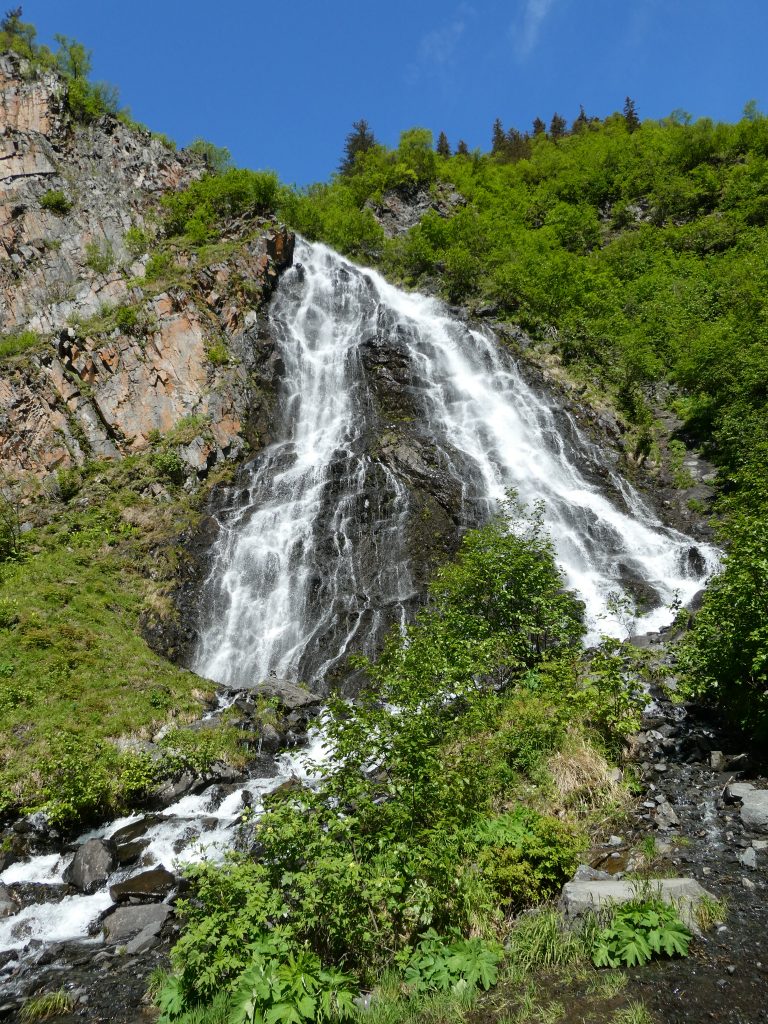Nights RV camping in Alaska can be spent in pretty spectacular places. K’esugi Ken Campground is a popular interior Alaska campground with views of Denali on a clear day. Photo courtesy Serine Reeves/The MILEPOST
Exploring the wilderness of Alaska from behind the wheel has been a tradition of road warriors for decades. For some, that means a trip to the Kenai Peninsula with ample passing lanes and full-service stops; for others it is a week-long muddy and bumpy marathon up and down the Dalton Highway. Either way, the scenery is breathtaking and the adventure memorable. Alaska truly has a lifetime of destinations for RV travelers. Here are some of the top spots for your next adventure in the five regions of Alaska: Southcentral, Interior, Arctic, Southeast, and Southwest.
Southcentral
Kenai Peninsula

The Kenai Peninsula is an angler’s paradise. Visitors can catch a chinook salmon in the emerald waters of the Kenai River or land a halibut in the depths of Kachemak Bay. In addition to fishing, this area is a playground of outdoor recreational opportunities: biking, hiking, kayaking, flightseeing, cruising, ziplining, and whitewater rafting, to name a few.
The Seward and Sterling highways are well-maintained, paved, and have frequent passing lanes, making them easy to navigate in any kind of rig. Visitors can find a campground every 20 to 30 miles on the peninsula, making it a perfect destination to get out and explore without too much planning. The major urban centers of Seward, Soldotna, and Homer all offer picturesque camping within walking distance of world-class fishing.
Travelers that venture to the end of the Sterling Highway will find themselves on the Homer Spit, a 4.5-mile strip of land jutting into Kachemak Bay. This unique geographic landmark offers campsites with panoramic ocean vistas against a backdrop of towering snowcapped mountains. The Homer Harbor is the centerpiece of many services on the spit, including restaurants, shops, and tours. Known as the “Halibut Capital of the World,” Homer sports deep-sea fishing charters as a main attraction.
Prince William Sound

Prince William Sound offers towering tidewater glaciers, dramatic mountain views, emerald-hued islands, and abundant marine wildlife, including humpback whales and porpoises. This stunning inlet is accessible from a few Alaska communities: Cordova, Whittier, and Valdez. Cordova is not connected to the road system, so visitors need to fly or take a ferry to visit this scenic port town. Whittier is located 60 miles south of Anchorage on the Seward Highway, making a great side trip for Kenai Peninsula travelers, and Valdez is located 300 miles from Anchorage via the Glenn and Richardson highways.
The Richardson Highway offers spectacular natural features that can all be seen from the driver’s seat, including Worthington Glacier, Thompson Pass, and Bridal Veil Falls, all within 30 miles of downtown Valdez. Travelers on this route can also stop at viewpoints of the Trans-Alaska Oil Pipeline that runs from Prudhoe Bay, on the shore of the Arctic Ocean, to Valdez, on the Pacific shore of Prince William Sound. This coastal community is beautiful on a clear day, with 360-degree views of the Chugach Mountains.
Valdez has several campgrounds with full hookups near restaurants and shops. Visitors can explore Old Valdez, the original townsite that was destroyed by the infamous Good Friday earthquake in 1964, charter a fishing trip, rent kayaks, or book a wildlife and glacier viewing cruise in Prince William Sound.
Matanuska-Susitna Valley

The Matanuska-Susitna Valley (actually two large valleys that converge), 50 miles north of Anchorage, is an agricultural hub famous for the giant vegetables that grow under the midnight sun each summer. Commonly referred to as the Mat-Su, this area has many public and private camping options and just as many activities to enjoy—everything from four-wheeling to horseback riding. With its many lakes, it is also a perfect location for watersports, jet boating, paddle boarding, kayaking, and canoeing. There are campgrounds near some of the area’s most popular features and attractions, including the magnificent Matanuska Glacier, historic Independence Mine, and expansive Susitna River drainage.
Talkeetna, the northernmost community of the Mat-Su, is a favorite among many for its mountain views, historic atmosphere, and active community. Established in 1916 to house the Engineering Commission Headquarters for construction of the Alaska Railroad, Talkeetna’s main street is lined with historic buildings that are still active restaurants and lodges today.
The town’s early twentieth-century streets are narrow and busy with pedestrian traffic, so large rigs need to park just outside of the town center. This bustling downtown has many gift shops, art galleries, restaurants, and tours for everything from ziplining to dog mushing. A short walk from the end of main street provides Susitna River access, a jumping off point for riverboat, float, or fishing trips. There is a wooded camper park with full hookups located five minutes walking distance from downtown Talkeetna.
On a clear day, Talkeetna offers stellar panoramic views of the Alaska Range. You can get a bird’s-eye view by booking a flightseeing trip out of the community’s small airport, which is also the jumping off point for hundreds of climbers attempting to scale Denali each summer.
Interior
Denali National Park

At 20,310 feet in elevation, Mount Denali is North America’s highest peak. It is surrounded by an untouched wilderness of towering mountains, serene lakes, and abundant wildlife. Due to its size, the mountain is frequently shrouded in clouds, so curb your expectations. Roughly 30 percent of visitors to Denali National Park are fortunate enough to catch a glimpse of Denali.
The park is accessible from the 92-mile-long Park Road. The first 15 miles of the road are open to the public, but if you want to see the park beyond Mile 15, you will need book a ticket on the school-bus-style National Park Service shuttle. Passengers frequently see brown bears, moose, and caribou in addition to dramatic and beautiful scenery.
For picturesque camping and convenient park access, the park offers RV camping at Riley Creek or Savage River campgrounds, but there are no full hookups. Full service private campgrounds can be found just a few miles from the entrance of the park in Nenana Canyon, a vibrant business district with tours, shopping, restaurants, and even dinner theater. These campgrounds fill up fast, so book in advance, or stay in the nearby communities of Cantwell or Healy.
Arctic
Dalton Highway

Alaska’s most remote, challenging, and dangerous highway is not your typical RV destination. This 415-mile patchwork of gravel, chip seal, and paved sections, coined “the Haul Road,” is used to haul freight to the North Slope oil fields in Prudhoe Bay. Expect mud in wet weather, dust in dry weather, potholes, and road construction, and be prepared to give freight haulers the right of way. Despite its notorious reputation, the Dalton is revered for its scenic beauty and excellent wildlife viewing opportunities. There are three major geographic attractions on the Dalton: the Yukon River, Arctic Circle, and Arctic Ocean. For those who want to cross the Arctic Circle or see the Arctic Ocean, braving the Dalton is their only option.
The Bureau of Land Management (BLM) has four campgrounds along the Dalton Highway: Milepost 60, Arctic Circle, Marion Creek, and Galbraith Lake campgrounds. The best one to stay at depends on what you want to check off your bucket list. If you want to see the Yukon River, venture to Milepost 60 Campground; and if you want to cross the Arctic Circle, journey to Arctic Circle Campground. BLM campgrounds offer basic campsites with no hookups. For full-service camping stay at Coldfoot Camp, located 60 miles past the Arctic Circle.
Prudhoe Bay/Deadhorse

If you drive to the end of the Dalton Highway, you will find yourself very close to Alaska’s northern coast, but if you actually want to dip a toe in the Arctic Ocean, you will need to book a tour with the Arctic Ocean Shuttle at Deadhorse Camp. Make reservations in advance. Deadhorse is not a typical town and there are no official campgrounds, but travelers can usually find a place to park their rig. There are also several informal campsites along the Sagavanirktok River south of Deadhorse.
Southeast
Inside Passage

Southeast Alaska is accessible to RV travelers via the Inside Passage, a network of waterways spanning from Bellingham, Washington, to Skagway, Alaska. You might be asking yourself, “How does one go about navigating an RV through inlets, fjords, and canals?” The Alaska Marine Highway System state ferry provides Inside Passage transportation for travelers and their vehicles. After driving your rig right into the ship’s hull, you can either tent camp on the deck of the vessel or rent a cabin. As the ferry travels between southeast ports, enjoy views of lush islands, snowcapped mountains, breaching humpback whales, and otters bobbing in the waves.
Inside Passage communities offer many cultural attractions: see ancient Tlingit and Haida totem poles in Ketchikan; explore Alaska’s capital city, Juneau; or experience Klondike Gold Rush history in Skagway. This region of Alaska also offers a wealth of natural attractions: book a cruise into Glacier Bay National Park from Gustavus, watch bears catch salmon at Anan Wildlife Observatory near Wrangell, explore the Tongass National Forest on Prince of Wales Island, or see one of the world’s largest concentrations of bald eagles in Haines.
A trip through the Inside Passage requires a lot of planning and preparation. Spaces for vehicles fill up fast on the Alaska state ferry and need to be booked well in advance. If you’re driving the Alaska Highway through Yukon, Canada, you can catch a glimpse of the Inside Passage without ferry travel by making a side trip across the Canada-U.S. border to Haines or Skagway, the only two southeast communities connected to the road system.
Southwest
Kodiak island

The Alaska state ferry also offers access to Kodiak Island in southwest Alaska. With access to more than 100 miles of road through lush rolling hills, rainforest, and scenic beaches, it’s no wonder Kodiak is coined the Emerald Island. Anglers flock to Kodiak every summer for its excellent freshwater and ocean fishing, catching coveted salmon and halibut. The island is also home to the largest brown bears in the world, making it a premium bear viewing destination. Visitors can also enjoy excellent whale watching tours, museums, hiking, and kayaking.
To fully experience Kodiak, plan on navigating some rough or narrow roads. The island offers a few public campgrounds and many opportunities for informal and beach camping, great for vans, trucks, or small campers. There are only a few spots to get full hookups, so plan on living without or making reservations.



Comments are closed.